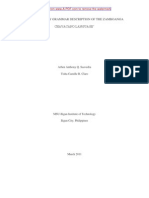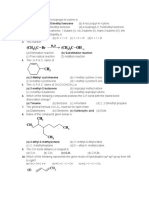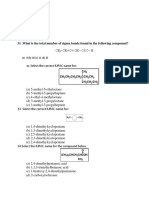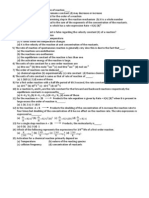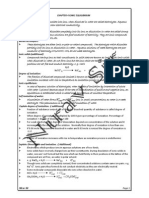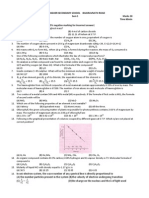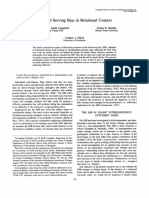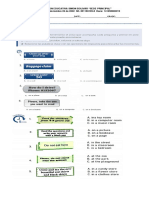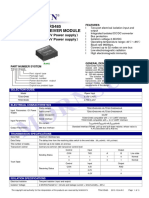Untitled
Untitled
Uploaded by
api-233404189Copyright:
Available Formats
Untitled
Untitled
Uploaded by
api-233404189Copyright
Available Formats
Share this document
Did you find this document useful?
Is this content inappropriate?
Copyright:
Available Formats
Untitled
Untitled
Uploaded by
api-233404189Copyright:
Available Formats
1. In which of the following species, all types of hybrid carbons are present ?
a. CH
2
= C = CH
2
b.CH
3
-CH=CH-CH
2
+
c. CH
3
- C
+
= CH
2
d.CH
3
-CH=CH-CH
2
2. Which of the following compounds, the underlined carbon has sp
3
- hybridization ?
a. CH
3
COOH b. CH
3
-CH
2
-OH c. CH
3
CONH
2
d. CH
3
-CH=CH
2
3. Which of the following carbon atoms is most electronegative ?
III II I
3
C H C C H
a. I b. II c.III d. All are equally electronegative
4. The structure of H
2
C = C = CH
2
is
a. linear b. planar c. non - planar d. has several resonance structures
5. Allyl isocyanide has
a. 9and 4 bonds b. 8 and 5 bonds c. 9 and 3 bonds d. 8 and 3 bonds
6. Which one of the following has sp carbon?
a. Acetonitrile b. Acetic acid c. Acetone d. Acetamide
7. Which organic structure among the following is not an isomer of the compound CH
3
- CO - CH
2
CH
2
CH
2
CH
2
?
a. CH
3
CH
2
OCH = CHCH
2
CH
3
b. CH
3
CH = CHCH
2
CH
2
CHO
c. (CH
3
)
2
CH - CO - CH
2
CH
3
d. CH
3
CH
2
COCH
2
CH
2
CH
3
8. The least number of carbon atoms in alkane showing isomerism is
a. 3 b. 1 c. 2 d. 4
9. The number of possible alkynes with molecular formula C
5
H
8
is
a. 2 b. 3 c. 4 d. 5
10. The total structural isomers of C
4
H
10
O are
a. 5 b. 7 c. 2 d. 4
11. The total number of isomers for C
4
H
8
a. 5 b. 6 c. 7 d. 8
12. The number of possible open chain (acyclic) isomeric compounds for molecular C
5
H
10
a. 8 b. 7 c. 6 d. 5
13. Ethylidene bromide and ethylene bromide are
a. Chain isomers b. Positional isomeres c. Functional isomers d. Metamers
14. The number of enantiomers of the compound CH
3
CHBrCHBrCOOH is
a. 0 b. 1 c . 3 d. 4
15. 2, 3 - Dimethyl butane and 2, 2- Dimethyl butane are
a. Positional isomers b. Chain isomers c. Metamers d. Functional isomers
16. The stability of 2,3-dimethyl but-2-ene is more than 2-butene. This can be explained in terms of:
a. Resonance b. Hyper conjugation c. Electromeric effect d. Inductive effect
17. Isomerism exhibited by acetic acid and Methyl formate is
a. Functional b. Chain c. Geometrical d. Central
18. How many structural formulae are possible for :
a. 6 b. 8 c. 10 d.12
19. The most stable carbonium ion is :
(a)
6 5 6 5
6 5
|
C H C C H
C H
(b)
6 5 6 5
3
|
C H C C H
CH
(c)
3
3
|
CH C H
CH
(d)
3
3
3
|
|
CH
CH C
CH
20. Which pair represents chain isomers ?
a.
3 2 2 2
and CH CHCl ClCH CH Cl
b. Propyl alcohol and isopropyl alcohol
c. 2-methylbutane and neopentane d. Diethylether and propylether
21. The number of different amines corresponding to the formula
3 9
C H N is
a. 2 b. 3 c. 4 d. 5
22. The first organic compound synthesised in the laboratory from an inorganic compound is
(a)
4
NH NCO (b)
2 2
NH CO NH (c)
3
CH COOH (d)
4
CH
23. The first cabon compound prepared from its elements is
(a) Urea (b) Acetic acid (c) Methane (d) Benzene
24. Organic compounds are numerous since
(a) Carbon has high catenation ability (b) Tetravalency of carbon
(c) Isomerism of organic compounds (d) All
25. Hybridisation of carbon atom in
3
CH
+
is
(a) sp (b) sp2 (c) sp3 (d) sp3d
26. which of the following has maximum C - H bond length
(a) C
2
H
4
(b) C
2
H
2
(c) C
2
H
6
(d) C
6
H
6
27. Hybridisation at 2nd carbon in CH
2
= CH - CH
3
is
(a) sp (b) sp2 (c) sp3 (d) sp3d
28. Which hybrid orbitals are involved in the CH3-CH = CH - CH3 compound
(a) sp and sp3 (b) sp2 and sp3 (c) sp and sp2 (d) only sp3
29. The ratio of and bonds in benzene is
(a) 3 :1 (b) 4 : 1 (c) 1 : 4 (d) 2 : 3
30. The ratio of pure and hybrid orbitals
(a) 7 : 12 (b) 14 : 13 (c) 6 : 5 (d) 5 : 6
31. C- H bond type in benzene is
(a) sp - s (b) sp
2
- s (c) sp
3
- s (d) p p
32. Which of the following is linear in shape ?
(a) Methane (b) Ethane (c) Ethene (d) Ethyne
33. Bond angle in ethene is
(a) 120
0
(b) 180
0
(c) 109
0
28
1
(d) 111
O
34. Which of the following does not contains all carbons with sp
2
hybridised ?
(a) C
2
H
4
(b) C
6
H
6
(c) CH
2
=CH - CH = CH
2
(d) CHC - C CH
35. In homologous series, the consecutive members differ in structural formula by
(a) CH (b) CH
3
(c) CH
2
(d) C
6
H
6
36. Pick out a set of homologous
(a) C
2
H
6
, C
2
H
4
, C
2
H
2
, C
2
H
5
(b) C
6
H
6
, C
7
H
8
, C
9
H
10,
C
9
H
12
(c) CH
4
, C
2
H
6
, C
3
H
8
, C
4
H
10
(d) C
2
H
2
, C
3
H
4
, C
4
H
6
, C
4
H
10
37. The % increase of s- character in the hybrid orbitals of carbon in , follow the order
(a)
4 2 4 2 2
CH C H C H > > (b)
2 4 4 2 2
C H CH C H < <
(c)
4 2 4 2 2
CH C H C H < < (d)
2 2 2 4 4
C H C H CH < <
38. Between the two carbon atom, the no. of & bonds present in respectively are
(a) 1,2 (b) 2, 1 (c) 5, 2 (d) 3, 2
39. The number of electrons present in naphthalene
(a) 6 (b) 10 (c) 5 (d) 12
40. The hybridisation of carbons C
1
and C
3
in the compound CH
3
- CH = CH-CH
3
(a) sp (b) sp
2
(c) sp
3
(d) sp
3
d
41. Which of the following molecular formula belongs to the alkyne series ?
(a) C
7
H
14
(b) C
10
H
22
(c) C
9
H
16
(d) C
16
H
32
42. Functional group present in amides is
(a) - COOH (b) -NH
2
(c) -CONH
2
(d) - COO
43.
O
||
-C-
group is present in
C
2
H
5
-C - CH-CH
3
|| |
CH
2
CH
3
(a) ketones only (b) aldehydes only (c) Carboxlic acid only (d) All the above
44. Which of the following compounds has only secondary carbon atoms ?
(a) Cyclohexane (b) methyl cyclopentane (c)2 - methylpentane (d) pentane
45. I.U.P.A.C name of neo-pentane is
(a) 2- ethyl pentane (b) 2, 2- di methyl pentane (c) 2, 2- di methyl propane (d) 2- methyl
propane
46. I.U.P.A.C name of ester is
(a) Alkoxy alkane (b) Alkyl alkanoate (c) Alkanoyl halide (d) Alkanoic anhydride
47. But - 2- en- 1- ol is the I.U.P.A.C name of
(a) CH
3
-CH = CH CHO (b) CH
3
- CH - = CH - COOH
(c) CH
3
-CH= CH-OH (d) CH
3
- CH= CH - CH
2
OH
48. I.U.P.A.C name of methyl cyanide is
(a) Cyano methane (b) ethanenitrile (c) Methane nitrile (d) Methyl n butyl amine
49. I.U.P.A.C. name of CH
3
-O- CH
2
-CH
2
-CH
2
CH
3
is
(a) 1- butoxy methane (b) Methyl carbyl ether (c) Pentanone (d) 1 methoxybutane
50. The I.U.P.A.C.name of is
(a) 1,2 - dichoroethane
(b) 2,2 - dichloroethane
(c) 1,1 - dichloroethane
(d) Dichloroethane
51. The IUPAC of is
(a) 3- methyl-2- ethyl butyne -1
(b) 2- ethyl -3 - methylbutene-1
(c) 3- ethyl -3 -methyl- butene
(d) ethyl isoprpopyl ethane
52. The IUPAC name of CH
3
CH
2
CH
2
CO - CH
3
is
(a) 2- pentanone (b) Pentanone -2 (c) Pentan - 2- one (d) all are correct
53. IUPACname of the tertiary butyl alcohol is
(a) butanol -1 (b) butanol -2 (c) 2- methyl propanol -1 (d) 2- methyl propanol-2
54. The suffixes for alcohols , aldehydes and ketones, according to IUPAC system are respectively
(a) -ane , - al - keto (b) -ol -al - keto (c) -ol , - al, - one (d) -ol, -ane , -one
55. The correct IUPAC name of following is
(a) 1,2 -diethyl butene
(b) 2 - ethyl -3- methyl pentene
(c) 3 , 4 - dimethyl hex -3- ene
(d) 2 , 3 - dimethyl pent -2- ene
56. IUPAC name of is
2 2
CH OH CH OH
(a) 1, 2 - dihydroxy ethane (b) Ethylene glycol (c) Ethane - 1, 2- diol (d) Ethane - 1, 2 - dial
57. IUPAC name of is
2
CH C CH CH =
(a) But - 3 - ene - 1- yne (b) But - 1 - ene - 3 - yne(c) But - 1- yne - 3- ene (d) But - 3- yne - 1- ene
58. Structure of Prop - 2- ynal
(a)
3
CH C C OH
(b)
2
CH C CH OH
(c)
CH C CHO
(d)
2
CH CH CHO =
59. The lowest alkane which has ethyl group as substituent has IUPAC name
(a) 2-Ethylpropane (b) 2-Ethylbutane (c) 3-Ethylpentane (d) None of these
60. The correct IUPAC name of
2 5 4
( ) C H C is
H Cl
| |
H - C - C- Cl
| |
H H
CH
3
- C = C - CH
3
| |
CH
3
C
2
H
5
(a) Tetraethyl methane (b) 2-Ethylpentane (c) 3,3-diethylpentane (d) None of the above
61. The IUPAC name of the compound
3
( ) CH CONH Br is
(a) 1-Bromoacetamide (b) N-Bromoethanamide(c) Ethanoyl bromide (d) None of these
62. The structure of 4-methylpent -2-en-1-ol is
(a)
3 2 2
CH CH HC CH CH OH = (b)
3
3 2
|
CH
CH CH HC CH CH OH =
(c)
3
3 2 3
| |
OH CH
CH CH CH CH C CH =
(d)
3
3 2 2
|
CH
CH C CH CH CH OH =
63. The IUPAC name of the compound
2
CH CCH CH CH CH = = is
(a) Hexa-3,5-dien-5yne (b) Hexa-1,2-dien-1-yne (c) Hexa-1,3-dien-5-yne (d) Hexa-3,5-dien-1-yne
64. The IUPAC name of the compound
3
| |
CH COCH CH COOH
Cl I
(a) 2-Iodo-3-chloro-4-pentanoic acid (b) 4-Oxo-3-chloro-2-iodopentanoic acid
(c) 4-Carboxy-4,3-chloro-2-butanone (d) 3-Chloro-2-iodo-4-oxopentanoic acid
65. The IUPAC name of
(a) 4-Ethylpent-4-en-2-amine
(b) 2-Amino-4-ethylpent-4-ene
(c) 2-Ethylpentan-4-amine (d) 4-Amino-2-ethylpent-1-ene
66. Which of the following statement is incorrect? The members of the homologous series of alkanes
(a) are all straight chain compounds (b) have the general formula
2 2 n n
C H
+
(c) have similar chemical properties (d) show a regular gradation of physical properties.
67. Which of the following forms a homologous series?
(a) Ethane,ethylene,acetylene (b) Ethane,propane,butanone
(c) Methanal,ethanol,propanoic acid (d) Butane,2-methybutane, 2-3 dimethyl-butane.
68. Which of the following is cummulated diene ?
(a) 1,3-butadiene (b) Allene (c) Crotonylene (d) Allylene
69. The IUPAC name for isobutyl group is
(a) 2-Methylethyl (b) 1,1-Dimethylethyl (c) 2-Methylpropyl (d) 1-Methylpropyl
70. Systematic name of urea is
(a) Diaminoketone (b) 1- Aminoethanamide(c) 1-Aminomethanamide (d) Aminoacetamide.
71. The IUPAC name for the compound is
(a) Propylene oxide (b) 1, 2 -Oxopropane
(c) 1, 2 - Epoxypropane (d) 1, 2 - Propoxide
72. The correct IUPAC name of the compound is
(a) 1,2- dichloro propanone (b) 2 chloro propanylchlonide
(c) 1,2 - dichloropropanal(d) Chloroformly chloro ethane.
73. The correct IUPAC name of is
(a) Methoxy Propanone
(b) Methoxy Propanal
(c) Methyl Propanoate
(d) Methoxy ethyl ketone.
74. The correct IUPAC name of the compound is
(a) 1,2 Diethyl butane (b) 2 ethyl-3 methyl pentane
(c) 3,4 dimethyl hex-3-ene (d) None
75. One among the following is the correct IUPAC name for
CH
3
CH
2
N
H
C
H
O
the compound.
(a) N Formylaminoethane (b) N Ethylformylamine (c) N - Ethylmethanamide (d) Ethylaminomethanal.
76. Neoheptyl alcohol is correctly represented as
2 3
2 5 2 2
|| |
CH CH
C H C CH CH NH
2 3
/ \
O
H C CH CH
3 2 3
||
CH CH C OCH
O
3 3
2 5 2 5
| |
CH C C CH
C H C H
=
(a)
3
3 2 3
3
|
| |
CH
CH C CHCH CH
CH OH
(b)
3
3 2 2 2 3
|
|
CH
CH C CH CH CH CH
OH
(c)
3
3 2 2 2
3
|
|
CH
CH C CH CH CH OH
CH
(d)
2 5
2 5
2 5
|
|
C H
C H C OH
C H
77. The common name of
3 3 2 5
( ) CH CC H is
(a) Isohexane (b) Neohexane (c) Trimethylpropane (d) None is correct
78. The family to which methoxyethene belongs is
(a) hydrocarbon (b) ketone (c) unsaturated ether (d) ester
79. The correct IUPAC name of acetonitrile is
(a) Cyanomethane (b) 2-Ketopropanenitrile (c) Methanenitrile (d) Ethanenitrile
80. The correct IUPAC name of
3 2 3 2 5 2
( ) ( ) CH CH CH CH CH C H is
(a) 4 - Ethyl - 3 methylhexane (b) 3 - Ethyl - 4 methylhexane
(c) 3 - Methyl - 4 ethylhexane (d) 2 - Isopentylbutane.
81. The correct IUPAC name of is
3 3
||
O
CH C OCOCH
(a) Methyl ethanoate (b) Acetato ethanoate (c) Ethanoic anhydride (d) Ethanoyl ethanoate
82. The correct IUPAC name of is
(a) Tricarboxymethane
(b) Propanetrioic acid
(c) Tributanoic acid
(d) Methanetricarboxylic acid
83. The IUPAC name of compound
3 2 2 2 2 3
CH OCH CH CH OCH CH is
(a) 1-Ethoxy-3-methoxypropane (b) Ethoxy propaneoxymethane
(c) 3-Ethoxy-1-methoxypropane (d) 2.5-Dioxyhexane
84. The IUPAC name of compound is
(a) Propanetricarbylamine
(b) 3-Cyanopentane - 1, 5 dinitrile
(c) Propane - 1,2,3-tricarbonitrile
(d) Propane-1,2,3-trinitrile
85. IUPAC name of the following compound is
2 2 2
( ) CH CH CH CH CH = =
(a) 3,3-Divinyl-1-propene (b) Triethenylmethane (c) Trivinylethane (d) 3-Vinylpenta-1,4-diene
86. IUPAC name of
3
( ) CH CH OH COOH is
(a) Lactic acid (b) Hydroxypropionicacid (c) Carboxypropanol (d) 2-Hydroxypropanoic acid
87. A student named the compound as 1,4-butadiene
(a) The name is correct (b) He committed an error in the selection of carbon chain
(c) He committed an error in position of double bond (d) Unpredictable
88. Which of the following structure represents 2,2,3-trimethylhexane ?
(a)
3 3 2 2 2 3 2
( ) ( ) CH C CH CH CH CH CH (b)
3 3 2 3 2 3
( ) ( ) CH CH CH CH CH CH CH CH
(c)
3 3 2 3 2 2 3
( ) ( ) CH C CH CH CH CH CH CH (d)
3 3 2 2 3 2 3
( ) ( ) CH C CH CH C CH CH
89. The IUPAC name of
2 5 2 2
( ) C H NCH CHClCOOH is
(a) 2-Chloro-4-ethylpentanoic acid (b) 2-Chloro-3-(N,N-diethylamino) propanoic acid
(c) 2-Chloro-2-oxo-diethylamine (d) 2-Chloro-2-carboxy-N-ethylethane.
90. The IUPAC name of the following compound is
(a) 2-Cyclohexylbutane (b) Sec-Butylbenzene
(c) 3-Cyclohexylbutane (d) 3-Phenylbutane.
|
HOOC CH COOH
COOH
2 2
| | |
CH CH CH
CN CN CN
3 2 3
6 5
|
CH CH CH CH
C H
91. The compound which has one isopropyl group is
(a) 2,2,3,3-Tetramethylpentane (b) 2,2-Dimethylpentane
(c) 2,2,3-Trimethylpentane (d) None of the above
92. The correct IUPAC name of is
(a) Butane-2,4-dione
(b) Formyl ethanoate
(c) Acetic anhydride
(d) Ethanoic methanoic anhydride
93. The correct IUPAC name of the is
(a) 3-Aldo-2-oxopropanoic acid
(b) 2,3-Dioxopropanoic acid
(c) 1-Hydroxy propane-1,2,3-trione
(d) 2-Aldo-2-Keto methanoic acid
94. Electrophiles are :
(a) Electron loving species (b) Electron hatingspecies (c) Nucleus loving species (d) Nucleus hating species
95. Nucleophiles are
(a) Nucleus loving species (b) Electron loving species (c) Nucleus hating species(d) Electron hating species
96. A nucleophilic reagent must necessarily have
(a) An overall positive charge (b) An overall negative charge
(c) An unpaired electron (d) A species with complete octet and lone pair of electrons
97. Which of the following statements is false about an electrophile?
(a) Electron-deficient species (b) An acidic reagent
(b) A reagent which attacks an electron -deficient site in a molecule.
(c) A species which seeks a pair of electrons.
98. Which of the following species is an electrophile?
(a)
2
H O(b)
3
NH (c)
2 5
C H OH (d)
3
SO
99. Which of the following species is a nucleophile ?
(a)
2
NO
+
(b)
2
CX (c)
2
..
: NH
(d)
3
.
CH
100.Which of the following does not show electromeric effect?
(a) Alkenes (b) Ethers (c) Aldehydes (d) Ketones
101.Which is least stable ?
(a)
CH
3
(b)
CH
3
CH
2
(c)
CH
3
CH
3
CH
(d)
CH
3
CH
3
CH
3
C
102.Resonance effect involves
(a) Delocalization of - electrons along a conjugated system
(b) Delocalization of - electrons along a conjugated system
(c) Delocalization of -electrons into an adjacent - bond
(d) All are correct
103.In which of the following molecules, the substituent does not exert its resonance effect ?
(a)
6 5 2
C H NH (b)
6 5 3
C H N H
+
(c)
6 5
C H OH (d)
6 5
C H Cl
104.Which of the following represents the correct order of stability of carbocations ?
(a)
3 3 2 2 6 5 2 3 2
( ) ( ) CH C CH CH CH C H CH CH CH
+ + + +
> = > >
(b)
6 5 2 2 2 3 3 3 2
( ) ( ) C H CH CH CH C H CH C CH CH
+ + + +
> = > >
(c)
2 2 6 5 2 3 3 3 2
( ) ( ) C H C H C H C H C H C H C C H C H
+ + + +
= > > >
(d)
3 3 6 5 2 3 2 3 2
( ) ( ) ( ) CH C C H C H CH CH CH C H
+ + + +
> > >
105.Hyperconjugation involves
(a) Delocalization of o-electrons into an adjacent - bond
(b) Delocalization of -electrons into an adjacent double bond.
O
O
O
H
|| || ||
O O O
H C C C OH
(c) Delocalization of - electrons into an adjacent - bond
(d) All are true
106.Hyperconjugation effect is also called
(a) Baker-Nathan effect (b) Anchimeric assistance (c) No bond resonance (d) All are correct
107.Which of the following group has the maximum hyperconjugation effect ?
(a)
3
CH
(b)
3 2
CH CH
(c)
3 2
( ) CH CH
(d)
3 3
( ) CH C
108.Which of the following carbocations is most stable ?
(a)
3 2
CH C H
+
(b)
2
CH C H
+
= (c) CH C
+
(d)
6 5
C H
+
109.Which of the following carbocations is least stable ?
(a)
6 5 2
C H CH
+
(b)
2 6 4 2
p NO C H CH
+
(c)
3 6 4 2
p CH O C H CH
+
(d)
6 4 2
p Cl C H CH
+
110.The dipole moment of vinyl chloride is lower than that of methyl chloride . This is due to
(a) Resonance effect (b) Inductive effect (c) Electromeric effect (d) Hyperconjugation effect
111.Which of the following compounds will produce the most stable carbonium ion ?
(a)
3 2
3
|
CH CH CH OH
CH
(b)
3
3
3
|
|
CH
CH C OH
CH
(c)
3 2 3
|
CH CH CH CH
OH
(d)
3 2 2 2
CH CH CH CH OH
112.The order of abstraction of primary, secondary and tertiary hydrogen atoms in alkanes by a halogen atoms follows the
sequence
(a) 3 2 1
> > (b) 3 1 2
> > (c) 1 2 3
> > (d) 2 3 1
> >
113.Which of the following statements about resonance is not correct?
(a) The different resonating structures of a molecule have fixed arrangement of atomic nuclei
(b) The different resonance structures of a molecule should have same number of unpaired electrons
(c) The hybrid structure has equal contribution from all the resonating structure
(d) None of the individual resonating structures explains the various characteristics of the molecule.
114.Which of the following carbocation is the least Stable ?
(a)
CH
2
(d)
3
3
3
|
|
CH
CH C
CH
+
(b)
2
CH CH
+
= (c)
2 2
CH CH C H
+
=
115.P-chlorophenol is stronger acid than phenol because
(a) Cl is less electronegative than oxygen atom
(b) Of the-I effect of a halogen which is greater than its +R effect
(c) Of +R effect of Cl which is stronger than its-I effect
(d) Of +R effect of Cl.
116.The stability of a carbonium ion (carbocation) seconds upon
(a) The bond angle of the attached group
(b) The substrate with which it reacts
(c) The inductive effect of the attached group
(d) None of the above
117.Which of the following species is paramagnetic in nature?
(a) Free radical (b) Carbonium ion (c) Both (a) and (b) (d) None of these
118.In the carbonium ion, the carbon atom bearing positive charge is____ hybridised
(a) sp (b) sp
2
(c)sp
3
(d) unhybridised
119.The shape of carbanion is
(a) Linear (b) Planar (c) Pyramidal (d) None
120.State of hybridisation of carbon atom of carbene in the triplet state is
(a) sp
2
(b)sp (c) sp
3
(d) None of these
121.The bond that undergoes heterolytic cleavage most readily is
(a) C-C (b) C-O (c) C-H (d) O-H
122.The shape of the carbonium ion is
(a) Triangular planar (b) V-shaped (c) Pyramidal (d) None of these
123.Carbanion is iso-structural with
(a) Free radical (b) Carbonium ion (c) Ammonia (d) Carbene
124.Delocalisation of electrons involving -bonds known as ____effect.
(a) Mesomeric (b) Tautomeric (c) Electromeric (d) Hyperconjugative
125.Which one of the following series contains electrophiles only?
(a)
2 3 3
, , H O SO H O
+
(b)
3 2 3
, , NH H O AlCl (c)
3 3 2
, , AlCl SO NO
+
(d)
2 3
, , H O Cl NH
+.
126.The order of stability of free radical is
(a) Tertiary > Allyl > Benzyl(b) Allyl > Benzyl >Tertiary (c) Benzyl >Allyl >Tertiary(d) Tertiary > Benzyl > Alyl
127.Inductive effect involves :
(a) - e
(b) - e
(c) Both (d) None
128.Which of the following is active species in sulphonation of benzene?
(a)
2 4
H SO (b)
3
SO (c)
3
HSO
+
(d)
3
SO
+
129.Which of the following substituent has +M effect ?
(a)
2
NH (b) CHO (c) C N (d)
2
NO
You might also like
- ThesisDocument123 pagesThesisArben Anthony Saavedra QuitosNo ratings yet
- CAMBIO AUTOMÁTICO Toyota A340 E, F Ou HDocument2 pagesCAMBIO AUTOMÁTICO Toyota A340 E, F Ou HZé Mirto100% (3)
- Production of AcetaldehydeDocument173 pagesProduction of AcetaldehydeMuhammad Awais100% (1)
- 14 CHEMISTRY Organic Chemistry Some Basic Principles & TechniquesDocument3 pages14 CHEMISTRY Organic Chemistry Some Basic Principles & TechniquesHasan shaikhNo ratings yet
- 13 CHEMISTRY Organic Chemistry Some Basic Principles & TechniquesDocument4 pages13 CHEMISTRY Organic Chemistry Some Basic Principles & TechniquesHasan shaikhNo ratings yet
- GOC Practice QueDocument23 pagesGOC Practice Quesaksham361sharmaNo ratings yet
- CH CHDocument7 pagesCH CHabhi kumarNo ratings yet
- 1 - Classification & Nomeclature of Organic CompoundsDocument8 pages1 - Classification & Nomeclature of Organic CompoundsarvindkrishnaNo ratings yet
- 01 Nomenclature For Nuture PDFDocument29 pages01 Nomenclature For Nuture PDFTRUPTIRANI PUROHIT50% (2)
- Exam Organic Chemistry I WhittenDocument19 pagesExam Organic Chemistry I WhittenDaniel Baylosis Asong67% (6)
- 12th FNT 01 Chem(STR) 22-23Document5 pages12th FNT 01 Chem(STR) 22-23Hifza BalouchNo ratings yet
- NomenclatureDocument9 pagesNomenclaturetusharbhatia2008No ratings yet
- Advanced Problems in OC by MSC_16th EditionDocument29 pagesAdvanced Problems in OC by MSC_16th EditionironmanisafeelingNo ratings yet
- Exercise 11Document15 pagesExercise 11dny001No ratings yet
- Oc MCQDocument6 pagesOc MCQRajendra ChikkamathNo ratings yet
- 01-General Organic Chemistry-Que.-Final-E PDFDocument55 pages01-General Organic Chemistry-Que.-Final-E PDFSumit MajumdarNo ratings yet
- DPP (1 TO ) ACME OrganicDocument20 pagesDPP (1 TO ) ACME OrganicRaju SinghNo ratings yet
- B SC 1 ObjectiveDocument8 pagesB SC 1 Objectiveakbar azamNo ratings yet
- Organic Chemistry QuestionsDocument56 pagesOrganic Chemistry QuestionsSahanaaNo ratings yet
- Alkenes Intro WS - SV - SPRING 2024Document5 pagesAlkenes Intro WS - SV - SPRING 2024stephenmichaelramdeenNo ratings yet
- Goc13 Iit Jee Best MaterialDocument2 pagesGoc13 Iit Jee Best MaterialKunalKumarSinghNo ratings yet
- 15 CHEMISTRY Some Basic Principles & Techniques HydrocarbonsDocument3 pages15 CHEMISTRY Some Basic Principles & Techniques HydrocarbonsHasan shaikhNo ratings yet
- GOC questionDocument10 pagesGOC questionPiyush RajputNo ratings yet
- Worksheet ChemistryDocument2 pagesWorksheet Chemistryholy3dollarsNo ratings yet
- VDA - 7 Carbon and Its CompoundDocument7 pagesVDA - 7 Carbon and Its CompoundArpit AgarwalNo ratings yet
- Chapter Five 2ND LessonDocument9 pagesChapter Five 2ND Lessonyousefahmed0207No ratings yet
- IUPAC NOMENCLATURE Work Sheet For IIT RevisionDocument11 pagesIUPAC NOMENCLATURE Work Sheet For IIT Revisionhotah61811No ratings yet
- 12th FNT 02 Chem(JP) 22-23Document3 pages12th FNT 02 Chem(JP) 22-23Hifza BalouchNo ratings yet
- IUPAC Nomenclature BTS SPECIAL Practice Sheet Prayas JEE 2025 RemovedDocument21 pagesIUPAC Nomenclature BTS SPECIAL Practice Sheet Prayas JEE 2025 Removedvijendrayadav7880No ratings yet
- NomenclatureDocument4 pagesNomenclatureprarthana200403No ratings yet
- KPS Academy Chakwal: Encircle The Correct OptionDocument3 pagesKPS Academy Chakwal: Encircle The Correct Optionali raza chughtaiNo ratings yet
- IUPAC Objective QuestionsDocument7 pagesIUPAC Objective Questionspivig90932No ratings yet
- I UpacDocument19 pagesI UpacJay DodiyaNo ratings yet
- Jee Adv IUPACDocument13 pagesJee Adv IUPACKRISHNA AGRAWALNo ratings yet
- 3.1.1 Naming Practice QuestionsDocument33 pages3.1.1 Naming Practice QuestionsAyaan RaufNo ratings yet
- IUPAC Nomenclature - JEE TSC PDFDocument21 pagesIUPAC Nomenclature - JEE TSC PDFShadowNo ratings yet
- Nomenclature of Organic Compound (11th)Document16 pagesNomenclature of Organic Compound (11th)Raju Singh100% (1)
- IUPAC MCQDocument12 pagesIUPAC MCQmahalakshmi periyasamyNo ratings yet
- Ua+ Chem 23i Iupac - MkaDocument7 pagesUa+ Chem 23i Iupac - Mkasinghanushriya0No ratings yet
- 768apni KakshaDocument31 pages768apni KakshaVimal PrasadNo ratings yet
- What Is The Total Number of Sigma Bonds Found in The Following CompoundDocument4 pagesWhat Is The Total Number of Sigma Bonds Found in The Following CompoundsubhasisknkNo ratings yet
- Iupac Name QuestionDocument16 pagesIupac Name Questionayesha sheikhNo ratings yet
- Classfication and Nomeclature of Organic ComoundsDocument4 pagesClassfication and Nomeclature of Organic ComoundsEunbyeolNo ratings yet
- Nomenclature of Organic CompoundsDocument16 pagesNomenclature of Organic CompoundsVibhu Mittal100% (1)
- CHM 102 Type ADocument5 pagesCHM 102 Type AadekanmioluwatumiseNo ratings yet
- Iupac NomenclatureDocument6 pagesIupac NomenclatureSANTOSH GUPTANo ratings yet
- s.5 Chem TestDocument12 pagess.5 Chem TestlubaajamesNo ratings yet
- Esr Nomenclature Test OasisDocument4 pagesEsr Nomenclature Test OasisAnamika Barnwal100% (1)
- Organic Chemistry 9th Edition Carey Giuliano Test BankDocument12 pagesOrganic Chemistry 9th Edition Carey Giuliano Test Bankmelissa100% (33)
- Introduction To Organic Chemistry TutorialDocument5 pagesIntroduction To Organic Chemistry TutorialDomNo ratings yet
- WS Class 11 Org ChemDocument4 pagesWS Class 11 Org ChemJavedNo ratings yet
- Nomanclature Type 1Document20 pagesNomanclature Type 1Vinod Kumar100% (2)
- Iupac Nomenclature QuizDocument4 pagesIupac Nomenclature Quizrishigullipalli2007No ratings yet
- Alkanes Alkenes AlkynesDocument10 pagesAlkanes Alkenes AlkynesPanda Boy100% (2)
- 13 DPP 01B Mixed Boc ExcelDocument3 pages13 DPP 01B Mixed Boc ExcelAbhirama Bhat U RNo ratings yet
- Organic Chemistry-1Document18 pagesOrganic Chemistry-1chindamlokesh491No ratings yet
- Chapter 3Document27 pagesChapter 3Christian Arm100% (1)
- Bonding and Hybridization in Organic CompoundsDocument4 pagesBonding and Hybridization in Organic CompoundsvkgNo ratings yet
- P24 Answers Kweyete AlbertDocument7 pagesP24 Answers Kweyete AlbertMuhammad HashirNo ratings yet
- Sir JP (Alkane Alkene Alkyne)Document3 pagesSir JP (Alkane Alkene Alkyne)kamranbugti18No ratings yet
- Molecular Devices: An Introduction to Technomimetics and its Biological ApplicationsFrom EverandMolecular Devices: An Introduction to Technomimetics and its Biological ApplicationsNo ratings yet
- Metallabenzenes: An Expert ViewFrom EverandMetallabenzenes: An Expert ViewL. James WrightNo ratings yet
- NEET National Eligibility Cum Entrance Test Chemistry Class 11 + 12 Volume I + Volume IIFrom EverandNEET National Eligibility Cum Entrance Test Chemistry Class 11 + 12 Volume I + Volume IINo ratings yet
- Common or Trivial Names of Some Organic CompoundsDocument14 pagesCommon or Trivial Names of Some Organic Compoundsapi-233404189No ratings yet
- Basic Concept of Chemistry 1Document15 pagesBasic Concept of Chemistry 1api-233404189No ratings yet
- DX K (A) DT DX K (A) (B) DT DX K (A) (B) DT DX K (A) DTDocument1 pageDX K (A) DT DX K (A) (B) DT DX K (A) (B) DT DX K (A) DTapi-233404189No ratings yet
- Nirav Sir: 2 + - (S) + (Aq) - (Aq)Document19 pagesNirav Sir: 2 + - (S) + (Aq) - (Aq)api-233404189No ratings yet
- UntitledDocument1 pageUntitledapi-233404189No ratings yet
- UntitledDocument16 pagesUntitledapi-233404189100% (1)
- Chapter - 6 Hydrocarbon Q 1:explain Classification of Hydrocarbons (3 Mark)Document16 pagesChapter - 6 Hydrocarbon Q 1:explain Classification of Hydrocarbons (3 Mark)api-233404189No ratings yet
- States of Matter - Gas and Liquid: Sem-IIDocument22 pagesStates of Matter - Gas and Liquid: Sem-IIapi-233404189No ratings yet
- The Entire Scientific and Technological Process Used For Isolation of The Metal From Its Ores Is Known As Metallurgy. Occurrence of MetalsDocument19 pagesThe Entire Scientific and Technological Process Used For Isolation of The Metal From Its Ores Is Known As Metallurgy. Occurrence of Metalsapi-233404189No ratings yet
- Q 2: Write A Note On Lewis Symbols.: Li Be B C N O F NeDocument23 pagesQ 2: Write A Note On Lewis Symbols.: Li Be B C N O F Neapi-233404189No ratings yet
- UntitledDocument2 pagesUntitledapi-233404189No ratings yet
- Chapter 7basic Principles of Organic Chemistry Q1. Which Compounds Are The Simplest Organic Compounds?Document14 pagesChapter 7basic Principles of Organic Chemistry Q1. Which Compounds Are The Simplest Organic Compounds?api-233404189No ratings yet
- Assignment For Iupac Nomenclature: CH - CH-CH - CHDocument5 pagesAssignment For Iupac Nomenclature: CH - CH-CH - CHapi-233404189No ratings yet
- UntitledDocument2 pagesUntitledapi-233404189No ratings yet
- Maya Swimwear V Maya Swimwear Bikini BattleDocument12 pagesMaya Swimwear V Maya Swimwear Bikini BattleFame AppealNo ratings yet
- Janella Chapter 01Document6 pagesJanella Chapter 01alexandreaguadalupe16No ratings yet
- WhizKids Questions-UneditedDocument5 pagesWhizKids Questions-UneditedSVTKhsiaNo ratings yet
- Research IntroductionDocument19 pagesResearch IntroductionRicaNo ratings yet
- Turtle DiagramDocument2 pagesTurtle Diagramgoran969No ratings yet
- Altered Speech Following Adenoidectomy A 20 Year ExperienceDocument5 pagesAltered Speech Following Adenoidectomy A 20 Year Experienceenfanat23No ratings yet
- Coke Vs Pepsi, 2001Document35 pagesCoke Vs Pepsi, 2001alaa_mehsen100% (3)
- Students Non-Tax Filers Statement-SignatureDocument3 pagesStudents Non-Tax Filers Statement-SignaturekshaymalNo ratings yet
- The Self-Serving Bias in Relational ContextDocument9 pagesThe Self-Serving Bias in Relational ContextSushmitaNo ratings yet
- Organic - Reagents FinalDocument27 pagesOrganic - Reagents FinalSankar AdhikariNo ratings yet
- 1 Eco-Friendly HouseDocument4 pages1 Eco-Friendly Housepoint.m2007No ratings yet
- Hypertext Mark Up Language: Jonalyn G. EbronDocument36 pagesHypertext Mark Up Language: Jonalyn G. EbronJOna LyneNo ratings yet
- PREPARACIÓN PREGUNTAS SABER 11 INGLES PARTE 1-2-3-4 Modificado PDFDocument13 pagesPREPARACIÓN PREGUNTAS SABER 11 INGLES PARTE 1-2-3-4 Modificado PDFGandy RodriguezNo ratings yet
- CE-LVD CertificationDocument2 pagesCE-LVD CertificationDuy ChuNo ratings yet
- Mba Executive (EMBA) : Karachi University Business School University of KarachiDocument32 pagesMba Executive (EMBA) : Karachi University Business School University of KarachiAli JafferyNo ratings yet
- Sneak Peek: An Introduction To Heritage BreedsDocument26 pagesSneak Peek: An Introduction To Heritage BreedsStorey Publishing100% (2)
- In Re: Webloyalty - Com, Inc., Marketing and Sales Practices Litigation - Document No. 36Document10 pagesIn Re: Webloyalty - Com, Inc., Marketing and Sales Practices Litigation - Document No. 36Justia.comNo ratings yet
- By: Rico V. Sagal Louienel Reusora Edmund John LeeDocument15 pagesBy: Rico V. Sagal Louienel Reusora Edmund John LeeRio MocorroNo ratings yet
- Datasheet - HK td301d485 7701767Document3 pagesDatasheet - HK td301d485 7701767gdwkpfpipbxnmkpilcNo ratings yet
- BIHRMDocument1 pageBIHRMLisan AhmedNo ratings yet
- Chapter 4 Desktop Publishing SoftwareDocument26 pagesChapter 4 Desktop Publishing Software2022852102No ratings yet
- Me Myself & Identity Online - Identity Salience On Facebook Vs NDocument101 pagesMe Myself & Identity Online - Identity Salience On Facebook Vs NRoxanne MendezNo ratings yet
- Multi Choice Questions On Income Approach K. C. Jhavar, Btech, Mba, Mval (Re) Retd. Asst. Gen. Manager, Erst S. B. Indore Govt. Regd. ValuerDocument8 pagesMulti Choice Questions On Income Approach K. C. Jhavar, Btech, Mba, Mval (Re) Retd. Asst. Gen. Manager, Erst S. B. Indore Govt. Regd. ValuerAnirban DeyNo ratings yet
- Statistical Inference For Two Samples: Learning ObjectivesDocument17 pagesStatistical Inference For Two Samples: Learning ObjectivesShiinNo ratings yet
- TDG 0018, 0019 & 0020 Rev - 0Document10 pagesTDG 0018, 0019 & 0020 Rev - 0Preeti goswamiNo ratings yet
- Tendernotice 1Document2 pagesTendernotice 1AM SureshNo ratings yet
- Emerging Technologies in Computing: Industries Influenced by TechnologiesDocument7 pagesEmerging Technologies in Computing: Industries Influenced by TechnologiesYan YanNo ratings yet
